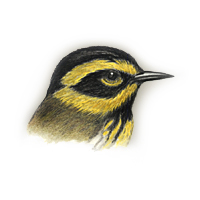 |
Townsend's Warbler
Dendroica townsendi |
|
|
STANFORD LOCATIONS: Uncommon migrant and winter resident in various habitat types throughout campus. A few can be found in oaks and eucalyptus trees near the Mausoleum in fall and winter. |
 |
Location |
Type |
Mating System |
Parental Care |
2ndary Diet |
Strategy |
|
|
|
|
I: 12? DAYS ALTRICIAL |
|
|
|
(7 feet - 60 feet) |
|
(3-5) MONOG |
F-M? |
|
| BREEDING: | Conif and conif-decid forests.? broods. |
| DISPLAYS: | ? |
| NEST: | Usu far out on horizontal branch of fir; relatively shallow, of grass, moss, cedar bark, fir twigs, plant fibers, lined with moss, feathers, hair. |
| EGGS: | White, marked with browns, usu mostly at large end but not wreathed. 0.7" (18 mm). |
| DIET: | Largely or entirely insects; also few seeds, plant galls. |
| CONSERVATION: | Winters s through highlands of Mexico to Costa Rica. Rare cowbird host. |
| NOTES: | Female allows close approach when incubating, then drops to ground and disappears. During summer, activities confined to highest parts of trees. In winter in N.A., joins mixed-species flocks of chickadees, nuthatches, etc.; in Mexico and C.A., often gregarious, forming single-species flocks and feeding on fruit and nectar. Birds breeding on islands off BC winter in U.S. and have longer wings and smaller bills than birds breeding elsewhere and wintering s of U.S. |
| ESSAYS: | Species and Speciation; Superspecies; Bird Guilds; Decline of Eastern Songbirds; Mixed-Species Flocking; Wintering and Conservation. |
| REFERENCES: | Harrison, 1984; Morrison, 1983. |
| Help | Abbreviations | Species-Alphabetical | Species-Taxonomic | Essays-Alphabetical | |
| Except for Stanford Locations, the material in this species treatment is taken, with permission, from The Birder's Handbook (Paul Ehrlich, David Dobkin, & Darryl Wheye, Simon & Schuster, NY. 1988). | |||||